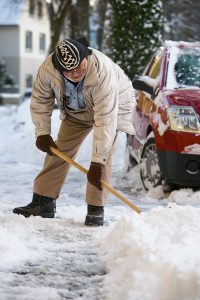Wintertime has its share of enjoyments — as well as risks for a wide variety of functional as well as recreational injuries, with the pandemic adding new challenges into the mix.
“As a result of COVID-19, more people will be participating in winter activities outdoors to get out of the house,” said John Gallucci Jr., MS, ATC, PT, DPT and CEO of Woodbridge-based JAG Physical Therapy. “But at the same time, both winter sports as well as routine things like shoveling snow may result in more injuries, as people haven’t been as active and/or aren’t at the gym as much as they used to be; they may also have gained weight and be out of shape as a result of the shutdowns and stay-at-home mandates in 2020.

“We’re definitely seeing more fractured wrists and elbows as well as soft tissue injuries as a result of people doing too much, too soon and taking on too much physical activity too quickly after being sedentary for much of this year,” Gallucci said. “We find that people are increasingly doing their own household chores such as making repairs to the exterior of their house or cleaning their own gutters instead of hiring contractors, which elevates the risk of injury. They’re eager to get out and ski, skate, walk and run because they’re going stir crazy indoors, but it’s important for everyone to be aware of and prepared for hazardous conditions like snow, black ice and more.”
To help you enjoy the cold weather season as safely and injury-free as possible, Gallucci shares the following tips:
• Prepare for Activity — Given the social distancing mandates and the fact that many people have been working from home, “A lot of people have been sedentary for months and not even logging the usual steps during their daily commute to work such as walking to the train, climbing stairs, etc.,” Gallucci said, adding that an abrupt return to outdoor activity can have undesirable consequences. “People are now going out, jogging too many miles, and feeling stiffness in their lower back and hamstrings from not being properly warmed up,” he said. “To avoid injury, you need to prepare for the rigors of winter with a warm-up component that involves stretching and a brief period of aerobic exercise beforehand.”
• Be Shrewd When Skiing — “Once ski season starts up, we’ll likely see more soft tissue injuries such as strains of the groin, hamstrings, low back and quadriceps because people aren’t prepared to take on the demands of this sport after being sedentary for so long,” Gallucci said. “Ideally, ski enthusiasts will condition with endurance activities like jogging, indoor or outdoor cycling, and swimming three to four times a week to build up their musculoskeletal system and mitigate the risk of soft tissue injuries.”
• Shovel with Care — To avoid the discomfort and damage that can result from movements individuals aren’t physically ready or warmed up for, “Simplistic stretching of the hamstrings, quads and low back as well as some jogging in place or other aerobic movement can better prepare the body to take on the lifting, turning and other rigors involved in shoveling snow,” he said. When shoveling, he added, “Lift snow with your legs (not your back), take your time, rest intermittently and be sure to stay well-hydrated because muscles can spasm if they get dehydrated.”
• Be Deliberate — “When outside, be cognizant of wet or icy conditions that could reduce traction and be sure to wear appropriate attire for winter weather,” he said. “Women and men should transfer from heels and hard-soled shoes, respectively, to boots designed for outdoor conditions, and everyone should avoid distractions (such as their cell phone) while walking in potentially hazardous conditions to minimize the risk of slip-and-fall injuries.”
• Get Treated for Injuries — In case of injury, “Physical therapy can help reduce its severity, accelerate the healing process, and return patients to full functionality and the ability to perform activities of daily living,” Gallucci said. Individuals who sustain soft tissue injuries not requiring surgical intervention — such as strains and sprains of the low back, quadricep, hamstring and shoulder muscles — should ideally seek physical therapy within 24 hours of the injury to minimize the damage, while people who do require surgery (for fractures, etc.) will typically engage in physical therapy once their physician approves them for such activity after surgery.
Overall, Gallucci urges people to make good choices during the winter so that they don’t spend the cold-weather months coping with injury. “Keep your wits about you, minimize distractions when you’re outdoors, and prepare your body for the activity to come so that you can enjoy the winter season safely and free of pain,” he said.
Visit a JAG Physical Therapy Clinic
Whether you're an athlete or just someone who wants to stay safe, there are steps you can take to reduce your risk of injury during the winter. To learn more about how to avoid winter injuries, contact JAG Physical Therapy today to schedule an appointment with one of our experienced physical therapists.
Learn More From JAG PT:
